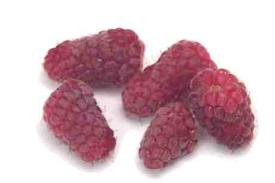 The loganberry, an accidental creation by James Harvey Logan, is best described as a cross between a blackberry and a raspberry. With a dark red color, this fruit has been popular since its creation in 1883 in the city of Santa Cruz, California. By the late 19th century, the Loganberry was being commercially produced around the southern part of the State.
The loganberry, an accidental creation by James Harvey Logan, is best described as a cross between a blackberry and a raspberry. With a dark red color, this fruit has been popular since its creation in 1883 in the city of Santa Cruz, California. By the late 19th century, the Loganberry was being commercially produced around the southern part of the State.
Like many people who eat a blackberry, Logan was unsatisfied with the harsh seeds embedded in the blackberry. With a vision of reducing this complexity, Logan tried his luck with a crossbreed of the Red Antwerp raspberry and the Texas Early blackberry. The attorney was successful in creating a fruit with smaller seeds, and soon, the berry was popular in Europe. Today, Loganberries are known for their beautiful color and delicious taste. Reaching maturity in late spring to early summer, you are sure to enjoy this delicate fruit raw, preserved or in a dessert or two.
Key Nutrients
Loganberries are a great source of vitamin C, manganese and B vitamins such as B2 and B6. Loganberries are also a great source of dietary fiber and are low in both saturated and unsaturated fat.
Health Benefits
Vitamin C – Regular consumption of foods rich in vitamin C helps the body develop resistance against infections and scavenges harmful, pro-inflammatory free radicals. Vitamin C also helps to prevent respiratory problems such as asthma and lung cancer. Vitamin C has been shown to lower blood pressure, and therefore lessen the probability of hypertension.
Manganese – Manganese aids in the metabolism of food as well as promotes normal functioning of the nervous system. Manganese works as an antioxidant to help prevent cancer and heart disease.
Vitamin B1 – Thiamine is an important vitamin since it breaks down sugars in the body. Thiamine also helps to support nerve and heart health.
Vitamin B6 – Vitamin B6 helps to keep your immune system in good working order. It aids in the breakdown of fats, carbohydrates and amino acids while helping to maintain the health of lymph nodes. Additionally, vitamin B6 helps to regulate blood glucose levels.
Vitamin B9 – Folate is an important vitamin for liver function.
Vitamin B12 – Vitamin B12, or folic acid, helps to preserve neurological function and DNA synthesis. It also plays a key role in the health of red blood cells. The nervous system relies on vitamin B12 for proper function as well.
Dietary Fiber – Dietary Fiber stimulates digestion and peristalsis, helping to relieve indigestion and constipation problems.
Season
Loganberries can be found fresh during the late Spring/Early Fall. Frozen berries can be found year round.
Nutrition Information
Per 1 cup (147 grams):
Calories (cKal): 81
Protein (grams): 2.23
Total Fat (grams): .46
Carbohydrates (grams): 19.14
Fiber (grams): 7.8
Buying and Storing
When buying loganberries, make sure the fruit is firm to the touch and free of blemishes. When storing at home, make sure to store in the refrigerator for up to four days.
Best Way to Add to Diet
Loganberries make a great addition to any breakfast cereal or parfait. Another great way to add longanberries to your diet is by serving them as a stew to any dessert or ice cream.
Loganberry Recipe

 Not Sure What Healthy Foods To Eat?
Not Sure What Healthy Foods To Eat? This week we take a look at one of my favorite healthy foods...the mighty Avocado.
This week we take a look at one of my favorite healthy foods...the mighty Avocado.
No comments yet.